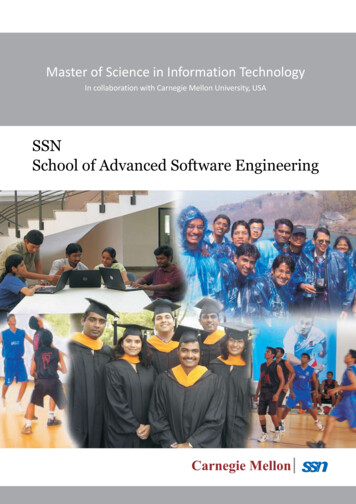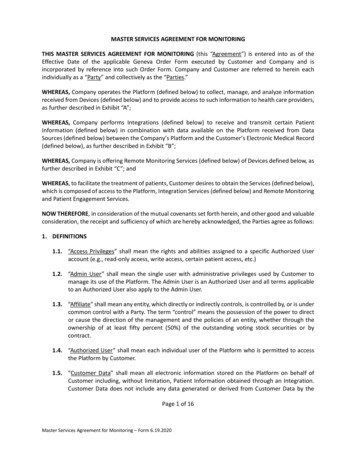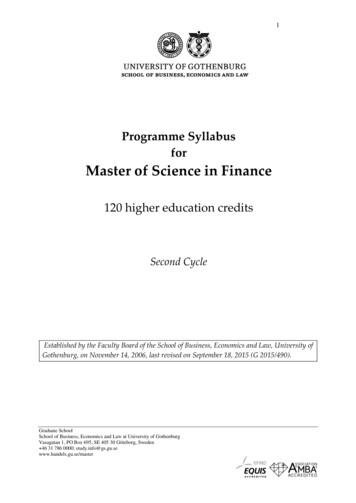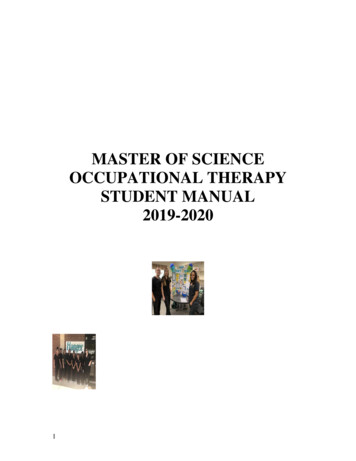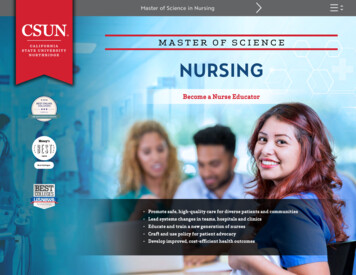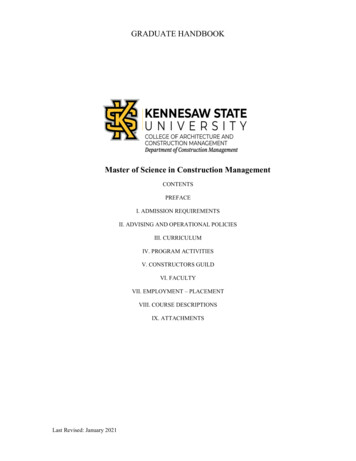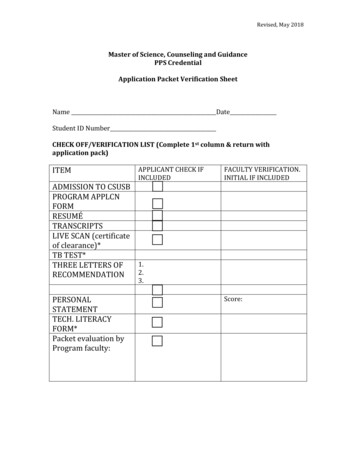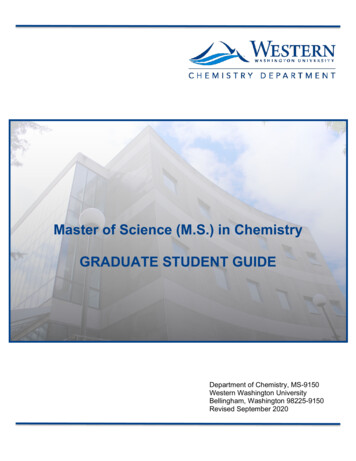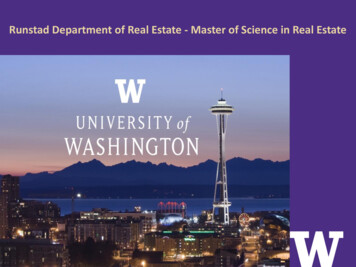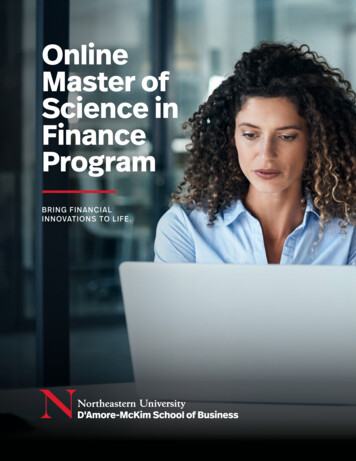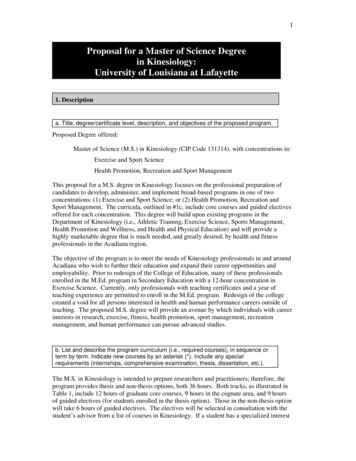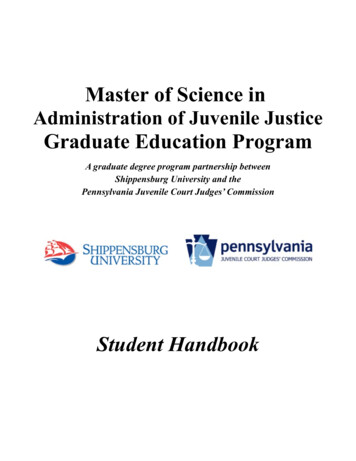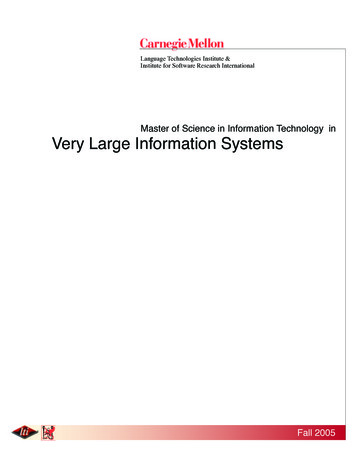
Transcription
Language Technologies Institute &Institute for Software Research InternationalMaster of Science in Information Technology inVery Large Information SystemsFall 2005
ContentsProgram . . . . . . . . . 1Focus . . . . . . . . . . . . . 2Curriculum . . . . . 3-5Placement . . . . . . 5Faculty . 6-7Environment . 8Application . 9-10Financial Aid . . 11Cost of Study. 11Housing . . . . . . . . . 11Contact . . . . . . . . . . 12Policies . . . . . . . . . . 12
ProgramWith the drastic drop in the price of storage and the rise of the internet, manyorganizations have deployed very large information systems, but are not equippedto manage them successfully and efficiently. The goal of the CMU professionaldegree program Masters of Science in Information Technology, specialization inVery Large Information Systems is to train a new generation of premiertechnologists who have the skills and knowledge to manage the layers oftechnology involved in VLIS deployments.Carnegie Mellon Universityʼs Master of Science in Information Technology(MSIT) graduate program is uniquely designed to provide working professionalswith this solid foundation. It offers a mix of technology and management coursesto provide students with an understanding of information technology from bothdevelopment and operational perspectives. The MSIT degree is a good investmentfor both information technologists and business professionals who want to deepentheir technical knowledge and develop their management skills.Very Large Information Systems (VLIS) are large repositories of data can be foundin industry, government, military, academic, and scientific settings. They take theform of internet content providers, business transactions, text, video, financialtransactions, genomic data, health care management, scientific data sets, etc.Currently, digital librarians manage the information, while responsibilities foroperating a VLIS falls to various system administrators, system architects anddatabase administrators. This diffusion of responsibility results in inconsistentinterfaces, a heterogeneous collection of systems that may not interoperateeffectively, and a general disjointedness and inefficiency.Through a comprehensive curriculum, the MSIT-VLIS program trains technologiststo coordinate all aspects of VLIS deployments. Graduates will have a unified visionof VLISs after being trained in the areas of Interaction, Analysis, Access, Storage,and Quality.The MSIT-VLIS curriculum draws from internationally recognized CMU facultyin many departments: Institute for Software Research International, LanguageTechnologies Institute, Center for Automated Learning and Discovery, Electricaland Computer Engineering Department, Human Computer Interaction Institute,Computer Science Department, and the Tepper School of Business.1
FocusThe MSIT-VLIS curriculum is unique among top universities world wide.This degree is a first-of-its kind to focus on a broad range of issues essentially tothe successful construction, deployment and user of VLISs. In keeping with thisobjective, students will have a unified vision of VLISs after exposure to theprincipal aspects of each of these sections.Access & UpdateThe access and update layer coversorganization of data into variousmodels.InfrastructureThe infrastructure layer covershardware and software at thedevice, network and operatingsystem level.InteractionThe interaction layer covers theinteraction between humans andcomputers.AnalysisThe analysis layer covers theextraction of informationfrom data.QualityThe quality layer covers issues that affects all aspects of a VLISdeployment: performance, reliability, security.2
CurriculumStudents will complete 10 courses and a project to earn the degree in one year. Thecurriculum consists of 6 core requirements, 2 courses in the studentʼs concentrationarea, 2 electives, and a capstone project.Core Courses:Introduction to Computer Security (18-730)Introduction to Computer Security provides an introduction to techniques fordefending against hostile adversaries in modern computer systems and computernetworks. Topics include operating system security; network securitycryptography and cryptographic protocols, firewalls, and network denial-ofservice attacks and defenses; user authentication technologies; security fornetwork servers; web security; and security for mobile code technologies, suchas Java and Javascript. More advanced topics will additionally be covered astime permits, such as: intrusion detection; techniques to provide privacy inInternet applications; and protecting digital content (music, video, software)from unintended use.Privacy Technology (17-702)This course introduces students to concepts and methods for creatingtechnologies and related policies with provable guarantees of privacy protection,while allowing society to collect and share person-specific information for manyworthy purposes. Methods include those related to the identifiability of data,record linkage, data profiling, data fusion, data anonymity, de-identification,policy specification and enforcement and privacy-preserving data mining.Students get hands-on experience at being “data detectives” by building dossiersfrom publicly available information and identifying individuals from seeminglyanonymous data. Students also learn to be “data protectors” by developing andassessing privacy protocols, algorithms and anonymity protection schemes toprotect inferences in shared data. Students learn a 6-prong approach at assessing and constructing technologies that are provably fit for a stated purpose in asocial-legal-organizational setting. Emerging technologies examined include:face recognition software, biometrics, survillance systems, personal information capturing tools and position location technology (GPS, E911 telephones,IR tags). Related topics are drawn from: data mining, information retrieval, webtechnology, computer security, cryptography, relational databases, statistics andpolitical philosophy.Information Retrieval (11-741), SpringThis course studies the theory, design, and implementation of text-basedinformation systems. The IR core components of the course include importantretrieval models, including Boolean, vector space, probabilistic, inference net,language modeling; clustering algorithms; automatic text categorization; andexperimental evaluation. The course covers a variety of current research topics,including cross-lingual retrieval, document summarization, machine learning,and topic detection and tracking.3
Artificial Intelligence: Machine Learning (15-681), Fall/SpringThis course focuses on computer programs that automatically improve theirperformance through experience. This course covers the theory and practice ofmachine learning from a variety of perspectives. Topics include: decision trees,neural network learning, statistical learning methods, genetic algorithms, Bayesian learning methods, explanation-based learning, and reinforcement learning.We study theoretical concepts such as inductive bias, the PAC and Mistakebound learning frameworks, minimum description length principle, and OccamʼsRazor. Programming assignments include hands-on experiments with variouslearning algorithms.Human Computer Interaction for Computer Scientists (05-TBA), SpringThis course introduces the skills and concepts of Human Computer Interaction(HCI) that enable computer scientists to design systems that effectively meet human needs. This course covers iterative design processes, interactive prototypeconstruction, discount evaluation techniques, and the historical context of HCI.Software Engineering for IT (11-791), FallThis course covers the fundamentals of software engineering for informationtechnology, including project management and software methodology. A basicunderstanding of programming is required. Students will analyze, design, andplan a specific software project. There are no programming assignments in thiscourse, but students may implement their plan from this course in 11-792.Very Large Information Systems (17-TBA), SpringThis course teaches principals of distributed and parallel database technology:distributed query processing, parallel query processing, distributed transactionprocessing, failure and recovery, federated databases, etc. and provides a forumto combine lessons learned from the core curriculum into a unified framework.ConcentrationEvery student is required to complete at least two courses in their selectedconcentration. The following concentrations are currently available:Databases18-746 Storage Systems17-801 Privacy Policy, Law, andTechnology, or 17-802 Privacyand Anonymity in Data18-821 Mobile Systems18-842 Distributed Computing18-845 Internet Services15-410 Operating SystemsComputational Biology15-856 Computational MolecularBiology and Genomics15-879 Computational StructuralBiology15-899 Computational GenomicsLanguage Technologies11-711 Algorithms for NaturalLanguage Processing11-718 Conversational Interfaces11-751 Speech Recognition11-731 Machine TranslationManagementThis concentration is still underconstruction. We will add anadditional course to the two minicourses listed below.45-775 Business Management45-750 Managerial Economics4
Elective Courses:The following are permitted elective courses students might take:Any graduate course in the School of Computer ScienceAny Carnegie Mellon course, if cleared by the program directorIn particular, the following mini-courses are encouraged, where appropriate:95-718 Professional Speaking (Mini)95-717 Professional Writing (Mini)Capstone ProjectFor the capstone project, students will work at Carnegie Mellon on a researchproject, or on an industry-sponsored project, during the summer. The project, whichconsists of three months of full time work related to the studentʼs concentration,must be approved by the program director. Students will record their experiences ina project report.PlacementCorporations are interested in graduates with intensive technological informationmanagement and sufficient technical background to understand VLISs in depth.Graduates will have a deep understanding of the technology of VLISs and willbe prepared to manage all aspects of a VLIS from requirements analysis to postdeployment analysis and maintenance. Graduates of this program are eminentlyqualified for industrial positions.5
FacultyJamie CallanJamie Callan is an associate professor in the School of Computer Science LanguageTechnologies Institute (LTI) and H. John Heinz III School of Public Policy andManagement. While his background is in Information Retrieval (IR) and MachineLearning, his interests include a range of information access and analysis topics.His groupʼs current research is oriented around 4 projects. Federated Search(“Distributed IR”), Accurate Document Filtering, Large-Scale Text Analysis:,and IR for Language Applications.Callanʼs students initially work closely with him to study specific ideas whilelearning research skills and IR. As students gain expertise, they developtheir own interests and have more freedom in exploring them.http://www.cs.cmu.edu/ callanAndrew MooreAndrew Moore is a professor of Robotics and Computer Science at the Schoolof Computer Science. His main research interest is data mining: the exciting worldof algorithms for finding all the potentially useful and statistically meaningfulpatterns in massive sources of data. Data mining is a rewarding area in which towork because the fundamental data structures, algorithms and mathematics arebeautiful. And itʼs a way for Computer Science to have a direct impact in the realworld. His research group, The Auton Lab, works with Astrophysicists, Biologists,Marketing Groups, Bioinformaticists, Manufacturers and Chemical Engineers.http://www-2.cs.cmu.edu/ awm/Eric NybergEric Nyberg is an Associate Professor at Carnegie Mellon University, with ajoint appointment in the School of Computer Science and the Heinz School ofPublic Policy and Management. He is co-director of the MSIT-VLIS program.Eric joined the Center for Machine Translation (CMT) at Carnegie Mellon in 1986.Since then, his research projects have focused on Knowledge-Based MachineTranslation (KBMT) for practical applications; most notably, the KANTSystem, which has been deployed for Caterpillar, Inc. When the CMT expandedinto the Language Technologies Institute (LTI) in 1996, he became involvedin curriculum development and teaching. He currently teaches a two-coursesequence in Software Engineering for Information Technology, as well as twolaboratory courses in Natural Language Processing and Machine Translation.http://www-2.cs.cmu.edu/ ehn6
Michael ReiterMichael Reiter is a professor of Electrical and Computer Engineering andComputer Science, and Technical Director of CyLab. His research interestsinclude computer and communications security and distributed computing.Reiter regularly publishes and serves on conference organizing committees. He hasserved as the program chair for the flagship computer security conferences of theInstitute of Electrical and Electronics Engineers (IEEE), the Association forComputing Machinery (ACM), and the Internet Society. He currently serves asEditor-in-Chief of ACM Transactions on Information and System Security, on theeditorial board of the International Journal of Information Security, and on theBoard of Visitors for the Software Engineering Institute. He previously servedon the editorial boards of IEEE Transactions on Software Engineering and IEEETransactions on Dependable and Secure Computing, and as Chair of the IEEETechnical Committee on Security and Privacy.http://www.ece.cmu.edu/ reiter/Latanya SweeneyLatanya Sweeney is an Associate Professor of Computer Science, Technologyand Policy in the School of Computer Science at Carnegie Mellon University. Shefounded and serves as the Director of the Data Privacy Lab, which works withreal-world stakeholders to solve todayʼs privacy technology problems. Her workinvolves creating technologies and related policies with provable guarantees of privacy protection while allowing society to collect and share person-specific information for many worthy purposes.Sweeneyʼs work has received awards from numerous organizations, including theAmerican Psychiatric Association, the American Medical Informatics Association,and the Blue Cross Blue Shield Association. Her work has appeared in hundreds ofnews articles, numerous academic publications, and was even cited in the originalpublication of the HIPAA Privacy Rule. Companies have licensed and continue touse her privacy ney/index.html.Anthony TomasicAnthony Tomasic is a Senior Systems Scientist in the Institute for SoftwareResearch International at Carnegie Mellon University. He is co-director ofthe MSIT-VLIS program. His research interests focus on very large informationsystems and the application of machine learning to the desktop.He has worked as an officer for various internet start-ups and a researcher forDyade, a research and development consortium established by Institute National deResearche en Informatique et en Automatic (INRIA) and the Group Bull. Tomasicwas scientific director for the team of students and engineers that built Disco, adistributed heterogeneous database system.Tomasic has worked as a researcher for the IBM Almaden Research Center, theEuropean Computer-Industry Research Centre (ECRC), and the Database Groupat Stanford University, where he completed his Ph.D. work on the performance ofdistributed information retrieval search engines. He earned an MS and a Ph.D. fromthe Department of Computer Science at Princeton University.7
EnvironmentCarnegie MellonCarnegie Mellon is a private research university with a distinctive mix of programsin computer science, robotics, engineering, the sciences, business, public policy,fine arts and the humanities. More than 8,000 undergraduate and graduate studentsreceive an education characterized by its focus on creating and implementingsolutions to solve real problems, interdisciplinary collaboration and innovation. Asmall faculty-to-student ratio provides an opportunity for close interaction betweenstudents and professors. While technology is pervasive on its 110-acre campus,Carnegie Mellon is also distinctive among leading research universities because ofconservatory-like programs in its College of Fine Arts.For more information, visit www.cmu.edu, www.lti.cmu.edu, www.isri.cmu.edu.PittsburghBoasting safe neighborhoods, a low cost of living, and an abundance of educationaland cultural activities, Pittsburgh has consistently been ranked near the top of RandMcNallyʼs Most Livable Cities index. The downtown district at the confluence ofthe Allegheny and Monongahela Rivers encompasses fine stores, restaurants, andtheaters for the performing arts. Pittsburgh is also the home of major league teamslike the Steelers, Pirates, and Penguins. The Oakland neighborhood aroundCarnegie Mellon juxtaposes international restaurants, coffee houses, shops,alternative cinema, and the Carnegie Museums of Art and Natural History.For more information, visit www.pittsburgh.net or www.realpittsburgh.com.8
ApplicationWho should apply?The MSIT-VLIS program is geared toward individuals with a degree in ComputerScience, Computer Engineering, or a related degree from a “top-twenty” university,or foreign equivalent. The typical applicant has a minimum of one year ofexperience in industry and seeks a new job at the bottom tier of the technicalmanagement hierarchy. This degree will provide the “leg-up” to management tier.How to applyRead the following instructions carefully and make certain that you have met allrequirements before you submit your application. All materials must be received bythe Admissions Committee no later than July 1, 2005 in order to be considered foradmission for the coming Fall semester. The MSIT-VLIS does not accept Springadmissions.1. Complete a cover sheet that lists the following information: full name,address, telephone number, e-mail address, undergraduate and graduate degreesand cumulative grade point average, and industrial experience.2. Prepare a Statement of Purpose. Type or print neatly a concise one- or twopage statement in the format below.Part I: Briefly state your objective in pursuing a professional graduate degree inMSIT-VLIS. Tell us if you have a particular reason for applying to this degree.Part II: Describe your background in fields particularly relevant to yourobjective. List here any relevant industrial or commercial experience.Part III: Include any additional information you wish to supply to theAdmissions Committee.3. Submit transcripts from all undergraduate and graduate institutions attended,even if no degree was granted. Transcripts should be in an official sealedenvelope and mailed with your application.4. Enclose your current resume, including a summary of research & industrialexperience and a list of publications (if any). Include copies of any publications(in English only) that you may have.6. Take the Graduate Record Examination (GRE) and have scores sent directlyto Carnegie Mellon University (Institutional Code 2074, Departmental Code0402). All applicants must take the General Test. It is recommended thatapplicants to the MSIT-VLIS program submit a subject test. Please refer to theGRE testing schedule (http://www.gre.org/testdate.html) to determine test dates.No application will be considered complete until we have received these scores.GRE scores will not be accepted if more than five years old.9
7. Take the Test of English as a Foreign Language (TOEFL) and have your scoresent directly to Carnegie Mellon University (Institutional Code 2074,Departmental Code 78). All students whose native language is not English musteither take this examination, or have earned an undergraduate degree from aU.S. educational institution.8. Submit the application. Mail all required materials, including the a
Eric Nyberg is an Associate Professor at Carnegie Mellon University, with a joint appointment in the School of Computer Science and the Heinz School of Public Policy and Management. He is co-director of the MSIT-VLIS program. Eric joined the Center for Machine Translation (CMT) at Carnegie Mellon in
